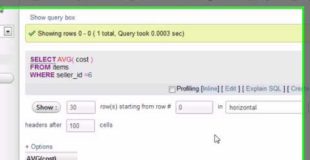Facebook – https://www.facebook.com/TheNewBoston-464114846956315/ GitHub – https://github.com/buckyroberts Google+ …
Original source
MySQL Database Tutorial – 18 – More on Aggregate Functions


Facebook – https://www.facebook.com/TheNewBoston-464114846956315/ GitHub – https://github.com/buckyroberts Google+ …
Original source
36 responses to “MySQL Database Tutorial – 18 – More on Aggregate Functions”
Is shampoing supposed to be champagne?
5:1 😀
yes sir
you made me go to an eBay and browse stuff lol
Hi Bucky, do these MySQL clips you present here are only for begginers? or if I master all of that, does that covers most of what needs to be know by someone who works on a regular basis with MySQL scripts?
Thanks man
5700 must be the bikini. LMAO you're funny as hell.
I have a problem, when I order the database by the price, I should get the used car (id=33) as the maximum, however it appears in the middle:
Linkbuzz | 582.75 | 67 | 49
Muxo | 580.62 | 4 | 18
used car | 5700.5 | 12 | 50
Topicware | 549.39 | 3 | 11
It seams that it takes 5700.5 as 570.05 but why?
Shampoing is the french word for Shampoo.
Great video btw !
SELECT COUNT(dracula) FROM Transylvania WHERE time BETWEEN dusk AND dawn
can we use Two queries in one statement using AND. For example SELECT AVG (cost) form items AND SELECT COUNT (name) FROM items WHERE seller=6
Suuurrrrree… had someone else create the table.
Hey Bucky… I've got a question for you… I used a "," after "avg" on the third row and it didn't work. Why is that?
SELECT COUNT(*) AS item_count,
MAX(cost)AS max,
AVG(cost)AS avg <—————
FROM items WHERE seller_id=12
Have you ever thought that "Shampoing" is a poor spelling of "Champagne".. who knows (well i guess the writer).
Great video!
Please teach us Oracle Bucky! 😀
Dat one person who had to dislike …..
I like all your tutorials Bucky thank you
DISTINCT SELECT DISTINCT name FROM customers
LIMIT SELECT name, zip FROM customers LIMIT 5, 10
OREDR BY SELECT name, id, address, state FROM customers ORDER BY state, name
SELECT name, id, address, state FROM customers ORDER BY state DESC
SELECT name, id, address, state FROM customers ORDER BY state DESC LIMIT 5
* SELECT * FROM customers
qualified name SELECT name. Address FROM customers
THAT MUST'VE BEEN THE BIKINI
Instead of using a function, you can directly multiply the value with 10.
Remember always makes sure you get the MAX AS
thank you
thank u
format output value*
Hi,
i was wondering what function i can use to formst out value to 1 place after the decimal.
if you can help me please and thank you
$5700 must be the bikini lol
0:55 "used diaper from my sister" HOLY CRAP XD
pretty cool huh
@regalme There is a series of videos by TheNewBoston on C# at j(dot)mp/Hkwdc1
I always wash my hair with shampoing
Hmmm, couldn't get this query to work. Error in ln 4 Where seller_id=12. Here's a paste of my commands, see if you can spot the error please???
SELECT COUNT(*) AS item_count,
MAX(cost) AS max,
AVG(cost) AS avg,
FROM items WHERE seller_id=12
@gtech2012 LOL, Bucky ain't no joke. . .I wonder how much of this stuff he knew before he got to UNC??
one word for bucky "Helper"
Time for some C# ASP .NET videos!!! come on bucky
hahaha – bucky is selling the dirty diaper from his sister… 😉
Good job!
more robot tutorials PLS!!!! 🙂